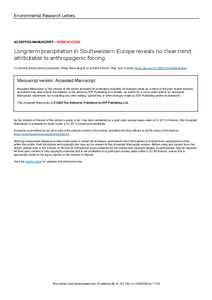Por favor, use este identificador para citar o enlazar este ítem:
http://hdl.handle.net/20.500.11765/12122
Long-term precipitation in Southwestern Europe reveals no clear trend attributable to anthropogenic forcing
Registro completo de metadatos
| Campo DC | Valor | Lengua/Idioma |
|---|---|---|
| dc.contributor.author | Peña Angulo, Dhais | es_ES |
| dc.contributor.author | Vicente Serrano, Sergio Martín | es_ES |
| dc.contributor.author | Domínguez Castro, Fernando | es_ES |
| dc.contributor.author | Murphy, Conor | es_ES |
| dc.contributor.author | Reig, Fergus | es_ES |
| dc.contributor.author | Tramblay, Yves | es_ES |
| dc.contributor.author | Trigo, Ricardo Machado | es_ES |
| dc.contributor.author | Luna Rico, Yolanda | es_ES |
| dc.contributor.author | Turco, Marco | es_ES |
| dc.contributor.author | Noguera, Iván | es_ES |
| dc.contributor.author | Aznárez-Balta, Marina | es_ES |
| dc.contributor.author | García-Herrera, Ricardo | es_ES |
| dc.contributor.author | Tomas Burguera, Miquel | es_ES |
| dc.contributor.author | El-Kenawy, Ahmed | es_ES |
| dc.date.accessioned | 2020-06-15T10:28:22Z | - |
| dc.date.available | 2020-06-15T10:28:22Z | - |
| dc.date.issued | 2020 | - |
| dc.identifier.citation | Environmental Research Letters. 2020, p. 1-23 | es_ES |
| dc.identifier.issn | 1748-9326 | - |
| dc.identifier.uri | http://hdl.handle.net/20.500.11765/12122 | - |
| dc.description.abstract | We present a long-term assessment of precipitation trends in Southwestern Europe (1850-2018) using data from multiple sources, including observations, gridded datasets and global climate model experiments. Contrary to previous investigations based on shorter records, we demonstrate, using new long-term, quality controlled precipitation series, the lack of statistically significant long-term decreasing trends in precipitation for the region. Rather, significant trends were mostly found for shorter periods, highlighting the prevalence of interdecadal and interannual variability at these time-scales. Global climate model outputs from three CMIP experiments are evaluated for periods concurrent with observations. Both the CMIP3 and CMIP5 ensembles show precipitation decline, with only CMIP6 showing agreement with long term trends in observations. However, for both CMIP3 and CMIP5 large interannual and internal variability among ensemble members makes it difficult to identify a trend that is statistically different from observations. Across both observations and models, our results make it difficult to associate any declining trends in precipitation in Southwestern Europe to anthropogenic forcing at this stage. | es_ES |
| dc.description.sponsorship | This work was supported by the research projects CGL2017-82216-R, CGL2017-83866-C3-3-R and PCI2019-103631, financed by the Spanish Commission of Science and Technology and FEDER; CROSSDRO project financed by the AXIS (Assessment of Cross(X) - sectoral climate Impacts and pathways for Sustainable transformation), JPI-Climate co-funded call of the European Commission and INDECIS which is part of ERA4CS, an ERA-NET initiated by JPI Climate, and funded by FORMAS (SE), DLR (DE), BMWFW (AT), IFD (DK), MINECO (ES), ANR (FR) with co-funding by the European Union (Grant 690462). | es_ES |
| dc.language.iso | eng | es_ES |
| dc.publisher | IOP Publishing | es_ES |
| dc.rights | Licencia CC: Reconocimiento CC BY | es_ES |
| dc.subject | Global climate model | es_ES |
| dc.subject | Precipitation trends | es_ES |
| dc.subject | Variability of climate | es_ES |
| dc.title | Long-term precipitation in Southwestern Europe reveals no clear trend attributable to anthropogenic forcing | es_ES |
| dc.type | info:eu-repo/semantics/article | es_ES |
| dc.relation.publisherversion | https://dx.doi.org/10.1088/1748-9326/ab9c4f | es_ES |
| dc.rights.accessRights | info:eu-repo/semantics/openAccess | es_ES |
| Colecciones: | Artículos científicos 2019-2022 | |
Ficheros en este ítem:
| Fichero | Descripción | Tamaño | Formato | ||
|---|---|---|---|---|---|
| PeñaAngulo_etal_2020... | 927,16 kB | Adobe PDF |  Visualizar/Abrir |
Los ítems de Arcimis están protegidos por una Licencia Creative Commons, salvo que se indique lo contrario.





